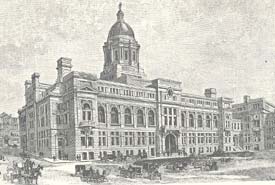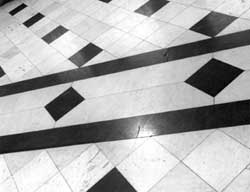Problems During Construction
The lengthy construction time for the Suffolk County Court House was due to several factors. The first was the necessity for public money to pay for it, which caused an unending political debate only hinted at by the legislative history. Squabbles were common between City Architect George A. Clough, the three members of the Commission assigned to oversee the construction (Solomon B. Stebbins, Thomas J. Whidden and Godfrey Morse), and the Board of Aldermen for the City of Boston. The wait for appropriations, occasional labor troubles, and changes in the plans compunded this personal infighting.[1]

The largest single change to architect Clough's plans was the decision not to build a proposed dome. A Committee of the Bar Association, made up of attorneys A.S. Wheeler, W.G. Russell, John C. Ropes, Robert M. Morse, Jr., and Thomas P. Proctor was instructed to consider "whether a dome or other structure should be erected upon the new Court House." They recognized that this matter "seems to involve a subject rather for architects than lawyers," but they reported their thoughts as asked in October of 1890. They agreed that the building would be "eminently satisfactory," if only put to its "actual uses." A tower or dome, they concluded, "would improve the appearance of the building, [but] the effect and value of such improvement would hardly be commensurate with the cost." Clough's dome would never be built.[2]
City of Boston Alderman Thomas F. Keenan seemed particularly critical of the Court House construction progress. At one rather inflammatory hearing on October 26, 1891, Keenan stated that the Commission was made up of "old broken-down politicians," especially Stebbins, who Keenan considered nothing more than a "creature of politics." Keenan further pointed out that there was no "single set of plans for the completion or construction" of the building, and that Clough and the Commissioners "are at sword's points." [3]

At another hearing on July 20, 1892, Keenan even asked if "there is a necessity for the Law Library up there [in the new Court House]?" The assistant architect, George E. Abbott answered "Yes, sir; it is in constant use." [Good thing for the Social Law Library.]
One late example of construction difficulties that plagued the building was the "extensive taking up and relaying of marble tiling" in early 1894, after many of the tenants had moved into their new quarters.
The relaying of the marble tiling was to replace pipes that had been destroyed already by "the electrolytic action of the lighting wires running in concrete or plaster under the tiling." The use of new technologies, even back in the 1890s, sometimes proved troublesome. [4]
Footnotes:
[1]PROCEEDINGS OF THE BOARD OF ALDERMEN. City of Boston, Oct. 22, 1894. City Doc. 175. 22nd and Final Report of Commissioners for the Erection of a New Court House for Suffolk County 916 (City of Boston, 1894).
[2]Id. at 975
[3] REPORTS OF PROCEEDINGS OF THE CITY COUNCIL OF BOSTON FOR THE YEAR 1074 (City of Boston, 1891).
[4] Supra note 1, at 916